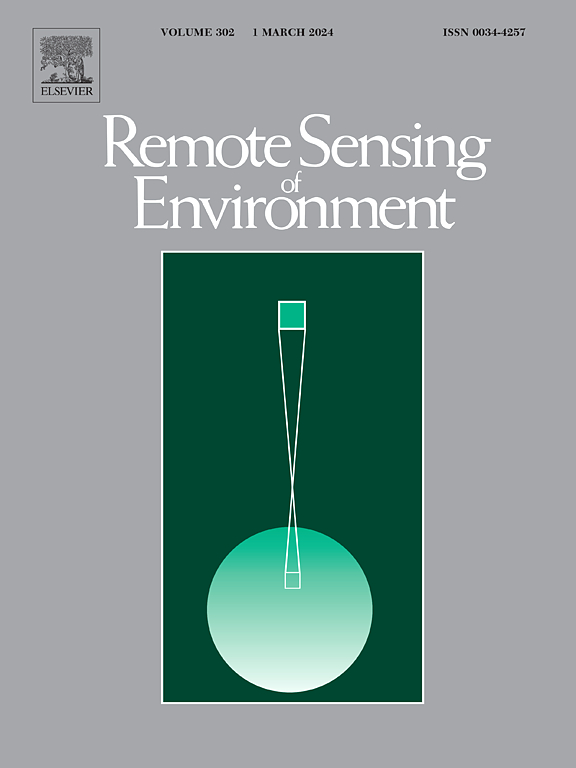Integrating near-infrared, thermal infrared, and microwave satellite observations to retrieve high-resolution precipitable water vapor
IF 11.1
1区 地球科学
Q1 ENVIRONMENTAL SCIENCES
引用次数: 0
Abstract
Various techniques have been developed to monitor water vapor because of its important role in weather forecasting and climate change studies. However, high-resolution, spatially continuous water vapor data remain scarce due to the sparsity of ground stations, coarse observational resolution, unavailability of remote sensing data during cloudy conditions, and systematic biases among different techniques. In this study we developed the Global Navigation Satellite System (GNSS) aided algorithms to retrieve Precipitable Water Vapor (PWV) from near-infrared (NIR), thermal infrared (TIR), and microwave (MW) observations from the Medium Resolution Spectral Imager II (MERSI-II) and the Microwave Radiation Imager (MWRI) onboard the Fengyun-3D satellite. We also proposed an improved iterative tropospheric decomposition algorithm to fuse the multiband PWV data, yielding the NIR + TIR PWV (0.01°), the MW PWV (0.25°), and the fused PWV (0.001°) for Australia. Validation against the GNSS PWV shows that the NIR + TIR PWV has a Root Mean Square Error (RMSE) of 1.45 mm and a bias of 0.07 mm, implying a 34 % improvement over the operational NIR products in terms of RMSE. The MW PWV shows RMSE and bias of 1.86 mm and 0.05 mm. The fused PWV integrates the advantages of different datasets, further enhancing the accuracy by 15 % for the NIR + TIR PWV and 21 % for the MW PWV. This study made the first attempt to retrieve PWV from three-band observations and delivers high-quality PWV products, which fills the data gap for high-resolution, spatially continuous PWV information.
整合近红外、热红外和微波卫星观测,获取高分辨率可降水量
由于水汽在天气预报和气候变化研究中的重要作用,人们开发了各种技术来监测水汽。然而,由于地面站稀疏、观测分辨率粗糙、多云条件下遥感数据不可用以及不同技术之间的系统偏差,高分辨率、空间连续的水汽数据仍然稀缺。在这项研究中,我们开发了全球导航卫星系统(GNSS)辅助算法,从中分辨率光谱成像仪II (MERSI-II)和微波辐射成像仪(MWRI)上的近红外(NIR)、热红外(TIR)和微波(MW)观测数据中检索可降水量(PWV)。我们还提出了一种改进的迭代对流层分解算法来融合多波段PWV数据,得到澳大利亚的NIR + TIR PWV(0.01°)、MW PWV(0.25°)和融合的PWV(0.001°)。对GNSS PWV的验证表明,近红外+ TIR PWV的均方根误差(RMSE)为1.45 mm,偏差为0.07 mm,这意味着在RMSE方面比实际近红外产品提高了34%。MW PWV的均方根误差和偏置分别为1.86 mm和0.05 mm。融合的PWV集成了不同数据集的优势,进一步提高了NIR + TIR PWV的精度15%,MW PWV的精度21%。该研究首次尝试从三波段观测中提取PWV,并提供了高质量的PWV产品,填补了高分辨率、空间连续PWV信息的数据空白。
本文章由计算机程序翻译,如有差异,请以英文原文为准。
求助全文
约1分钟内获得全文
求助全文
来源期刊

Remote Sensing of Environment
环境科学-成像科学与照相技术
CiteScore
25.10
自引率
8.90%
发文量
455
审稿时长
53 days
期刊介绍:
Remote Sensing of Environment (RSE) serves the Earth observation community by disseminating results on the theory, science, applications, and technology that contribute to advancing the field of remote sensing. With a thoroughly interdisciplinary approach, RSE encompasses terrestrial, oceanic, and atmospheric sensing.
The journal emphasizes biophysical and quantitative approaches to remote sensing at local to global scales, covering a diverse range of applications and techniques.
RSE serves as a vital platform for the exchange of knowledge and advancements in the dynamic field of remote sensing.
 求助内容:
求助内容: 应助结果提醒方式:
应助结果提醒方式:


